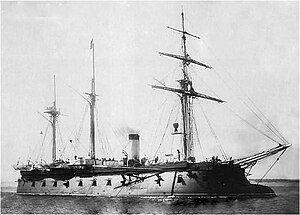Russian ironclad Pervenets

Pervenets at anchor
|
|
| History | |
|---|---|
|
|
|
| Name: | Pervenets (Russian: Первенец) |
| Operator: | Imperial Russian Navy |
| Ordered: | 18 November 1861 |
| Builder: | Thames Iron Works, Blackwall, London |
| Cost: | 917,000 rubles |
| Laid down: | December 1861 |
| Launched: | 18 May 1863 |
| Commissioned: | 28 July 1864 |
| Reclassified: | Coast defense ship, 13 February 1892 |
| Struck: | 15 September 1905 |
| Fate: | Sold for use as a barge, 8 August 1908 |
|
|
|
| Name: | Barzha No. 1 (Barge No. 1) |
| Acquired: | 30 June 1922 |
| Renamed: |
|
| Struck: | Late 1950s |
| Fate: | Scrapped, 1960s |
| General characteristics (as completed) | |
| Class and type: | Pervenets-class broadside ironclad |
| Displacement: | 3,277 long tons (3,330 t) |
| Length: | 220 ft (67.1 m) |
| Beam: | 53 ft (16.2 m) |
| Draft: | 14 ft 6 in (4.4 m) |
| Installed power: |
|
| Propulsion: | 1 shaft,1 × 3-cylinder horizontal return-connecting-rod steam engine |
| Sail plan: | Schooner |
| Speed: | 8 knots (15 km/h; 9.2 mph) |
| Complement: | 459 officers and crewmen |
| Armament: | 26 × 7.72-inch (196 mm) 60-pounder smoothbore guns |
| Armor: | Belt: 4–4.5 in (102–114 mm) |
The Russian ironclad Pervenets (Russian: Первенец) was a broadside ironclad built for the Imperial Russian Navy in Britain during the 1860s. The ship had to be built abroad as no Russian shipyard had mastered the techniques required to build iron-hulled armored vessels. She was assigned to the Baltic Fleet upon completion and never left Russian waters. Pervenets served with the Gunnery Training Detachment for her entire career until she was reduced to reserve in 1904. She was disarmed and stricken the following year and finally sold in 1908. After the end of the Russian Civil War, the ship was reacquired by the Soviets in 1922 and used to transport and store coal, a role she performed until discarded in the late 1950s. However, she was apparently not scrapped until the early 1960s.
The ship was designed as a coast defense vessel to protect the approaches to Saint Petersburg and was referred to as a "self-propelled armored floating battery". As such, a heavy armament and protection were the most important factors in the ship's design. No Russian shipyard could build iron-hulled, ironclad warships, therefore Pervenets was ordered from Great Britain. Her name means firstborn and refers to the Tsesarevich, heir to the Russian Empire.
Pervenets was 220 feet (67.1 m) long overall, with a beam of 53 feet (16.2 m) and a designed draft of 14 feet 6 inches (4.4 m). She displaced 3,277 long tons (3,330 t) and her iron hull had a pronounced tumblehome. Pervenets was fitted with large rams at bow and stern; the stern ram also serving to protect her rudder and propeller. The ship did not steer well and had "an unpredictable habit of suddenly lurching to one side or another", probably as a result of poor water flow to the rudder. She required six men to man her wheel and her total crew numbered 459 officers and men.
...
Wikipedia
